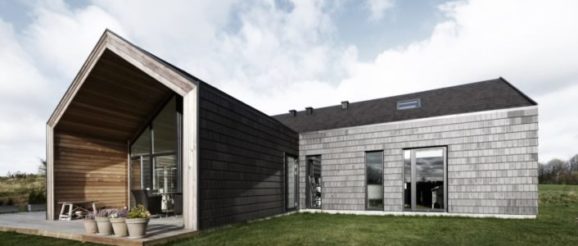Danish home champions wood over concrete for lower carbon emissions | Inhabitat – Green Design, Innovation, Architecture, Green Building

Danish architecture firm Tegnestuen LOKAL recently completed TK-33, a modern and energy-efficient home that promotes building materials considered more sustainable than those typically used in Danish residential construction. To reduce the carbon footprint of the project, the architects designed the home with a timber structure rather than the more commonly used load-bearing concrete walls. Triple-glazed windows and a flexible floor plan also add to the home’s environmentally friendly cachet.
Designed for an older couple, the TK-33 home is located on the outskirts of a small town north of Copenhagen. The single-story home spans 130 square meters with two bedrooms and a centrally located, open-plan living area that connects to a spacious L-shaped deck. The flexible layout allows the homeowners to easily adapt rooms to new uses without the need for renovation. Full-height glazing pulls the outdoors in while a natural materials palette ties the home to the rural landscape.
Driven by a desire to reduce carbon emissions in Denmark, the architects focused on replacing the most emission-heavy elements of typical Danish construction with more eco-friendly alternatives. In place of brick-clad concrete — commonly used for outer walls that the firm said account for nearly 30 percent of the total emissions associated with the construction of a typical home — the architects used a wooden frame clad in a thin layer of brick shingling. The slim brick facade is Cradle-to-Cradle certified and highly durable to ensure longevity.
“Eliminating emissions during construction, allowing for flexibility in the use of the house and facilitating reuse of the entire envelope makes for a house and a building technique that could decrease the emissions from the single-family house industry in Denmark greatly,” the architects said. “The house can be naturally ventilated and installations are pragmatically limited to the central core containing two bathrooms and a laundry room, lowering overall costs during construction.”
Photography by Jan Ove Christensen and Peter Jørgensen via Tegnestuen LOKAL
